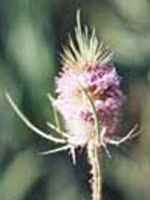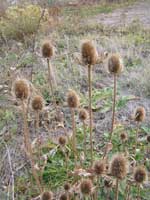Teasel
Dipsacus spp.
Keys to Identification
- Teasel is a biennial that can grow over 6 ft tall.
- The leaves at the base of the plant are dark green and appear rippled. The woody stems have downward facing spines.
- The flowers are purple or white and are seated within dense woody heads. There are distinctive fingerlike bracts at the base of the head.
- Teasel is found in moist areas but can also move into disturbed sites.
This information courtesy of the Colorado Natural Areas Program.
Family
Teasel (Dipsacaceae)
Other Names
Teasel, fuller’s teasel, Venus’s basin, card thistle, barbers brush, brushes and combs, church broom
USDA Code
DIFU2
Legal Status
Colorado Noxious Weed List B
Identification
Growth form
Biennial or sometimes monocarpic perennial forb.
Flower
Flowers are purple or white with spiny, awned bracts at the base. The bracts at the base of the head are generally longer than the head.
Seeds/Fruit
The fruits are four-angled, each contains a single seed.
Leaves
Rosette leaves are conspicuously veined, with stiff prickles on the lower midrib (Whitson et al 1996). Stem leaves are simple, opposite, net-veined, stalkless, and clasp the stem. Flowering plants have large, oblong, opposite leaves that form cups, which are capable of holding water (Wisconsin DNR 1998).
Stems
Mature plants can grow up to over six ft tall. The stem is rigid, furrowed (straight-angled), with several rows of downward turned prickles.
Roots
Shallow taproot with secondary fibrous root system.
Seedling
Forms a rosette.
Similar Species
Exotics
None known.
Natives
None known.
Impacts
Agricultural
Common teasel is not considered palatable and is generally ignored by livestock. It displaces native vegetation and decreases range quality.
Ecological
Common teasel can be an aggressive competitor in disturbed areas. Massive seed production and high germination allow it to quickly invade an area and out-compete other plants.
Habitat and Distribution
General requirements
Common teasel grows in open, sunny habitats that range from wet to dry levels. It is generally found along irrigation ditches, abandoned fields, pastures, waste places, and forests.
Distribution
Common teasel is spreading rapidly in America, particularly in the Pacific Northwest. In Colorado, teasel is usually found in relatively moist, disturbed situations but can also be found moving into drier areas.
Historical
Common teasel is a native of Europe where it has historically had many uses. The heads of a cultivated variety of teasel are used for wool “fleecing”, or raising the nap on woolen cloth. (Grieve 1995). These heads are fixed on the rim of a wheel, or on a cylinder, which is made to revolve against the surface of the cloth (Grieve 1995). No machine has yet been invented which can compete with teasel in its combined rigidity and elasticity (Grieve 1995). The roots of common teasel are also reported to have various medicinal values ranging from a remedy for jaundice to a cleansing agent (Grieve 1995).
Biology/Ecology
Lifecycle
Common teasel is a biennial or sometimes monocarpic perennial. The plant grows as a basal rosette for a minimum of one year, and then sends up a tall, flowering stalk (Wisconsin DNR 1998). After flowering and seed set, the plant dies (Werner 1975). Flowering occurs from July to August.
Mode of reproduction
Seed.
Seed production
A single teasel plant can produce over 2,000 seeds, of which 30-80% may germinate (Wisconsin DNR 1998).
Seed bank
Seeds can remain viable for at least two years.
Dispersal
No information available.
References
Grieve, M. 1995. Teasel, common. Internet 1/12/99. Available:http://www.botanical.com
PMIS. Noxious and Nuisance Plant Management Information System-version 4.0. CD-ROM.
Werner, P.A. 1975. The biology of Canadian weeds. 12. Dipsacus sylvestris Huds. Canadian Journal of Plant Science 55: 783-794.
Whitson, T.D.(ed.), L.C. Burrill, S.A. Dewey, D.W. Cudney, B.E. Nelson, R.D. Lee, R. Parker. 1996. Common teasel. Weeds of the West. Western Society of Weed Science, in cooperation with the Western United States Land Grant Universities Cooperative Extension Services, Newark CA. pg. 303.




